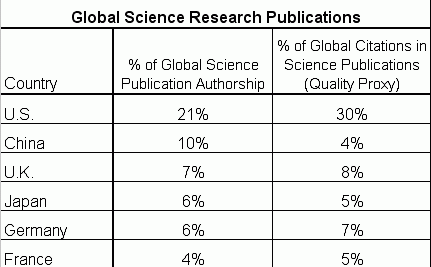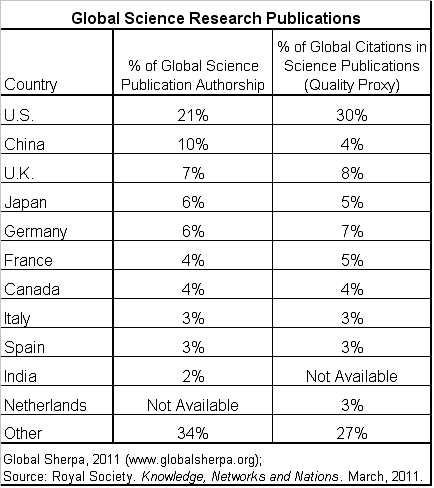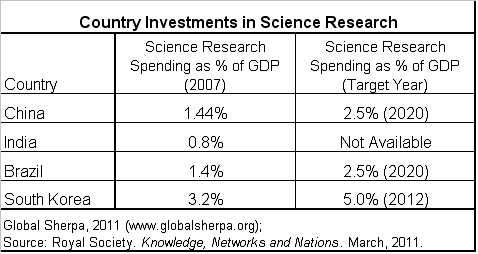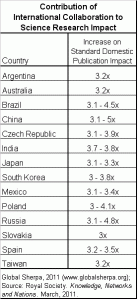Science research has grown rapidly in recent years. BRIC countries, including China, India and Brazil, and South Korea account for much of the increase in scientific publications. Despite suggestions of a major reversal in the global pecking order of science research, the U.S. continues to head rankings of research quality and influence. Regardless of relative standings and ample room for questions about data reliability, a recent report by the U.K.’s Royal Society paints an encouraging picture of the positive influence that global collaboration in science research has on scientific discovery, knowledge dissemination and addressing important global issues.
Global Science Research Statistics and Trends
Spending on Science R&D
Since 2002, global spending on science R&D has increased by 45 percent to more than $1,000 billion (one trillion) U.S. dollars. In 2008, 218 countries generated more than 1.5 million research papers, with contributions ranging from Tuvalu’s one paper to the U.S.’ 320,000 papers.
The U.S. leads the world’s production of science research, accounting for 21 percent of publications and nearly $400 billion worth of public and private science R&D. The top 10 countries, ranked by their authorship of science research publications, are shown in the chart below. The chart also presents each country’s share of citations in global science publications.
BRIC Countries – China, India and Brazil
Developing countries, particularly the emerging BRIC nations of China, India and Brazil, are responsible for a large portion of the increase in science research publications. The Royal Society study points out that these BRIC countries, along with South Korea, “are often cited as rising powers in science.” From 2002 to 2007, the three BRIC countries more than doubled their spending on science research, bringing their collective share of global spending up from 17 to 24 percent.
China’s development planning has targeted a number of scientific fields and related industries, including clean energy, green transportation and rare earths, among others. Since 1999, China’s spending on science R&D has grown 20 percent annually to more than $100 billion. By 2020, China plans to invest 2.5 percent of GDP in science research.
The Royal Society’s analysis of BRIC countries’ science research publications reveals some weighting toward certain fields. Engineering is a common focus of science research in China, India and Russia. Scientific fields in which China has developed a leading position include nanotechnology and rare earths. Agriculture and biosciences are two important fields of emphasis in Brazil, which is a leader in biofuels research.
In keeping with their rapid economic development and massive populations, China and India, the world’s first and second most populous countries, produce large and growing numbers of science and engineering graduates each year. In 2006, about 2.5 million students in India and 1.5 million students in China graduated with degrees in science and engineering.
South Korea
South Korea’s prolific research efforts are reflected in the country’s high ranking on the list of countries with the most patent registrations at the U.S. Patent Office. In 2009, South Korea ranked third on the list with 8,762 registrations, just shy of No. 2 Germany’s 9,000 registrations, but well off the pace of No. 1 Japan’s 35,501 registrations. South Korea’s U.S. patent registrations more than doubled from 3,562 registrations in 1999 and fewer than 500 registrations as recently as 1989, when it did not make the list of the top 11 countries.
The chart below presents recent and targeted figures for science research spending, where available, for China, India, Brazil and South Korea.
BRIC Cities – Beijing, Sao Paulo, Nanjing, Moscow
In the BRICs and many other countries, certain cities, states and regions tend to produce a disproportionate share of each country’s science research articles. Moscow accounts for more than 50 percent of Russian articles. Beijing and Sao Paulo each contribute more than 20 percent of China’s and Brazil’s publication totals.
Nanjing, China’s position in the world ranking of most science publications by city jumped 66 places into the top 20 cities between the periods 1996-2000 and 2004-2008. Nanjing is one of the Four Great Ancient Capitals of China (along with Beijing, Luoyang and Xian) and home to seven national universities, the People’s Liberation Army University of Science and Technology and numerous industrial parks.
International Collaboration in Science Research
Today, over 35 percent of science research articles are the result of international collaborations among researchers from different countries, a 40 percent increase from 15 years ago. The number of internationally co-authored papers has more than doubled since 1990.
The U.S., U.K., France and Germany continue to be key hubs of international collaboration in science research. Researchers in other developed and developing countries actively collaborate with scientists from these countries. According to the Royal Society report, “while links between the BRIC countries (Brazil, Russia, India and China) have been growing in recent years, they pale in comparison to the volume of collaboration between these individual countries and their partners in the G7.”
Regional Collaboration
International science research often takes the form of regional collaboration. For example, countries within the European Union or Africa may collaborate to address common issues. Regional political institutions, including the European Union (EU), African Union (AU) and the Association of Southeast Asian Nations (ASEAN), each have their own research strategies that foster and facilitate regional collaboration in science research. The Royal Society study identifies South Africa as “the linchpin of the continent’s collaborative efforts,” while “Egypt and Sudan have emerged as bridges between north and Sub-Saharan Africa.”
South-South Collaboration
“South-South Collaboration” is a growing form of international science research in which developing countries collaborate with one another to build capacity and share knowledge. The International Centre for South-South Cooperation in Science, Technology and Innovation was inaugurated in Kuala Lumpur, Malaysia in 2008 under the auspices of UNESCO. The IBSA Initiative of India, Brazil and South Africa promotes South-South cooperation in several arenas, including science and research collaboration in fields such as nanotechnology, oceanography and Antarctic research.
Key Benefits and Drivers of International Collaboration
There are a number of important benefits, motivations and enabling factors that help explain the growth of international collaboration in science research, including: 1) greater impact; 2) scientific discovery; 3) scale of research projects; 4) scope and complexity of research topics and international issues; 5) capacity-building; and 6) advances in technology and communications.
1. Greater Impact
International collaboration and joint authorship have a strong, positive influence on the impact of science research articles. The Royal Society study constructs a table of country pairings that shows the additional impact from collaborating with another country. Fourteen countries experienced more than a three-fold increase in their standard domestic publication impact by collaborating with one or more of 22 partner countries. Each additional international author leads to an increase in a paper’s impact, up to a tipping point of about ten authors. The chart below shows the range of impact multiples from international collaboration for the 14 countries. (Click on the image below to view the full-size chart in a separate browser tab.)
2. Scientific Discovery
Much of the international collaboration in science research is driven by scientists’ inherent desire to further their research and make new scientific discoveries. The Royal Society study describes science as a meritocratic field in which the best scientists seek out their peers around the globe, with relatively little regard for geographic boundaries. By collaborating with one another, scientists can access complementary skills and knowledge and stimulate new ideas.
3. Scale of Research Projects
The scale of some major science research projects is too large for most countries to undertake on their own. In such cases, international collaboration is necessary to meet extensive requirements for human, financial and other resources. The International Space Station and Large Hadron Collider are two examples of these types of very large-scale, international research endeavors.
4. Scope and Complexity of Research Topics and International Issues
The scope and complexity of certain science research topics and objectives can also drive international collaboration. These types of complex projects may involve many hundreds or thousands of parts that must be completed separately. The Human Genome Project and the First Census of Marine Life are two examples of projects where research activities needed to be allocated among a large, diverse pool of scientists around the world.
Many of the world’s most pressing social problems are international issues that call for collaboration and cooperation. Climate change, food security, public health (e.g., AIDS/HIV, malaria and tuberculosis) and sustainability are just a few of the global issues that require international collaboration and solutions.
5. Capacity-Building
Collaboration allows scientists in one country to build their capacity to conduct significant science research by leveraging the resources of partners in other countries. In addition to brain power and research experience, vital resources include funding and access to scientific facilities and instruments.
Collaboration can be particularly beneficial to partners from developing and developed countries. Developing countries can take advantage of the expertise, equipment and financial resources of developed country partners. For example, 77 percent of African biomedical research papers result from collaborations with international partners, while just 5 percent is a product of regional collaboration with other African countries.
In return, research partners from developed countries can gain access to local knowledge and data sources. Local access can be particularly beneficial to scientists conducting research in other countries, such as environmental research into local ecosystems and biodiversity.
6. Advances in Technology and Communications
Advances in technology have contributed greatly to the feasibility and appeal of international collaboration. For researchers in developing and developed countries alike, improvements in communication technologies and services have made international collaboration simpler, faster and cheaper than ever before.
Encouraging Success Stories
The Royal Society report calls attention to several encouraging examples of cases where science research and international collaboration have contributed greatly to addressing global food, health and other issues by reducing mortality rates and improving the quality of life.
Food Security and Agricultural Productivity
The Consultative Group on International Agricultural Research (CGIAR) facilitates research collaboration and the application of advances in agricultural technology and farming. Donors established the CGIAR in 1971 following a series of policy consultations led by the World Bank, U.N. Food and Agriculture Organization (FAO), United Nations Development Programme (UNDP), and the Rockefeller and Ford Foundations. CGIAR encompasses an international network of independent centers of agricultural research in Africa, Asia, Latin America and the Middle East.
The International Rice Research Institute (IRRI) in the Philippines and other CGIAR centers emphasize “their critical role in engaging and mobilizing local communities,” whose farmers can contribute valuable local knowledge in such areas as traditional rice varieties, soil conditions, farming practices and social and dietary preferences. Educating local communities on better farming methods is also a key component of CGIAR’s efforts and success. According to IRRI’s Director General, “IRRI was founded with a clear mandate to develop and conduct education in the production of rice in Asia. Research and education were seen to be equally important.”
CGIAR operates on a modest yet significant annual budget of $550 million. Every $1 invested in CGIAR is estimated to yield a very healthy return of $9 worth of additional food in developing countries.
Health – SARS
The World Health Organization (WHO) set up FluNet in 1996 as a global tool to monitor and evaluate influenza virus strains by leveraging data from a number of national influenza laboratories around the world. When the epidemic of severe respiratory illness broke out in Hong Kong in 2003, the FluNet network contributed to a coordinated, rapid response from the international science and medical community that identified the virus and helped minimize the related public health threat and consequences.
Health – Immunization
The Global Alliance for Vaccines and Immunization has immunized more than 200 million children and prevented over 3.4 million premature deaths since receiving a start-up grant of $750 million from the Bill and Melinda Gates Foundation in 1999. According to the Royal Society study, the Gates Foundation “has transformed global health research” by making up for market failures that prevent scientific research from finding solutions to the health problems that plague some of the poorest developing countries.” The Gates Foundation has devoted considerable funding and resources to R&D efforts aimed at combating the most devastating diseases in sub-Saharan Africa and other parts of the developing world, including AIDS, tuberculosis, malaria and other neglected tropical diseases.
Royal Society Study – Knowledge, Networks and Nations
These are some of the key findings published recently in the Royal Society’s examination of global science research entitled Knowledge, Networks and Nations: Global Scientific Collaboration in the 21st Century.
The Royal Society study is based on statistics from international organizations, including the United Nations Educational, Scientific and Cultural Organization (UNESCO), and the Society’s own analysis of data on science research articles published in roughly 25,000 separate scientific journals by the more than 7 million researchers around the world.
The Royal Society defines “science” as “natural knowledge,” which includes the natural sciences, mathematics and engineering. The global science research statistics cited in the study also include research in the social sciences, arts and humanities due to the way data are collected by UNESCO and other sources. The report takes the position that the latter only account for “a very small” 8.9 percent of total research publications.
Science research encompasses both research and development, the “R” and “D”, respectively, of public and private R&D efforts, which range from abstract and conceptual exploration through to market-oriented development of scientific applications.
Quality vs. Quantity
China could overtake the U.S. in the output of science publications as early as 2013 based on a simple linear extrapolation of current publication levels and rates of increase.
While this trend is noteworthy, the value of global science research relates more closely to the quality than the quantity of scientific publications. The quality of science research is challenging to measure and may only be known many years after research becomes available to the scientific community. One popular, albeit rough, measure of quality is the number of times one scientific research article is cited by other articles.
The research contributions of the U.S. and China are most affected by evaluating scientific publications by citations rather than article volume. During the period 2004-2008, U.S. science research accounted for 30 percent of global article citations, even though the U.S. only contributed 21 percent of article publications, as shown in the chart above. China accounted for just 4 percent of article citations, despite contributing 10 percent of article publications.
It’s worth emphasizing that citations have many shortcomings as a measure of research quality. For one, citations are lagging indicators. In addition, citations are a function of researchers’ awareness of and access to other articles and publications. In some cases, articles by researchers from China and other developing countries may receive fewer citations simply because they appear in publications that are less familiar to the international research community. On the other hand, the meritocratic, international nature of science research and the availability of searchable article databases facilitate access to science research from around the world.
Data Reliability Considerations – Sources, Language and Gray Research
Two noteworthy formats for publishing science research that are not included in the report’s statistics are foreign (non-English) language publications and so-called “gray research.” Gray research includes the large and growing body of technical reports, working papers, white papers and Internet publications from government agencies, NGOs and other research interests, which do not make their way into the peer-reviewed scientific publications referenced in the Royal Society study.
Prominent areas of gray research include agriculture and food security. Agriculture research, particularly involving developing countries, tends to be driven from the “bottom up” by the scientists and researchers themselves, who often rely on the participation of local farmers.
On one hand, peer-reviewed, English-language publications tend to contain research by the most prominent scientists and researchers, which is likely to be the most significant and influential. In addition, the Royal Society study suggests that English will continue to be the predominant common language of collaborative, global research efforts.
On the other hand, as the quantity and quality of scientific research from large, developing countries like China, India and Brazil increases, the exclusion of foreign-language publications could take on greater significance. This may be most applicable to certain fields where a large portion of research is conducted among scientists who speak a language other than English. For example, much of current research on vital rare earths is currently concentrated in China.
Research Findings and Policy Recommendations
The Royal Society study paints an encouraging picture of growing international investment in science research. International collaboration is a highly valuable mechanism for promoting scientific discovery and maximizing the impact of science research. Publicly and privately funded science R&D has played a key role in successfully addressing key issues related to public health, food security and the environment, among others.
Here are several recommendations on actions that could contribute to improving the evaluation, impact and application of science research.
- Measurements of Science Research Quantity and Quality – The Royal Society study could benefit from developing an effective method to incorporate or at least separately provide some assessment of non-English language and so-called “gray” research publications. In addition, it could contribute to international efforts to develop more effective methods for assessing the quality and value of science research.
- Promotion of International Collaboration – Governments, private donors, NGOs and other interests should make use of incentives and other mechanisms to promote more international collaboration in science research. One approach could involve setting aside a certain portion of funding for projects that meet relevant, consistent benchmarks for international collaboration. Another method might consist of linking matching research funding to collaboration with researchers in other countries, provided that collaboration furthers the research process and objectives.
- Development Policy and Science Research –Governments should make the promotion of science research a larger and more integral component of their development policies. Science research funding guidelines should be established jointly with development policy goals and objectives. Policy-makers could think of allocating development policy and funding to a portfolio of strategically aligned science research fields and corresponding projects.
- Let Scientists be Scientists – Scientific discovery tends to be an exploratory process that requires ample imagination, brainstorming, adaptation and persistence. Managers of science research efforts should considering taking a cue from a leading corporate innovator, 3M, and give their top scientists sufficient time and freedom to think and ponder what science can do to make the world a better place for all of us.
Related articles and content:
Global Sherpa country profiles and topic pages: BRIC Countries, China, India, Brazil, Korea, Japan, Development, Sustainability, World Rankings
BRIC Countries Discover Foreign Aid
China’s Development Plans Lead World, BRICs
News Trends in Sustainability, Development Issues
Scoring and Ranking the World’s Environmental Performance
Analyzing Global Progress: Interpreting the 2010 UNDP Human Development Report and Index




